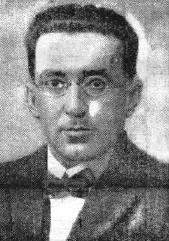Planica Nordic Centre
| Planica Nordic Centre Nordijski center Planica | |
|---|---|
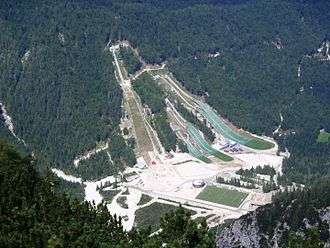 | |
| Location(s) |
Rateče-Planica, Municipality of Kranjska Gora, Slovenia |
| Inaugurated |
4 February 1934 (opened) 21 March 1969 (flying hill) 11 December 2015 (reconstruction) |
| Founder | Joso Gorec |
| Area | Upper Carniola |
| Activity | |
| Organised by | ZŠRS Planica |
| People |
Jelko Gros (CEO) Jure Žerjav (secretary) Ivan Rožman (constructor) Stanko Bloudek (constructor) Vlado Gorišek (constructor) Janez Gorišek (constructor) Klemen Kobal (constructor) |
| Member | K.O.P. |
Planica Nordic Centre (Slovene: Nordijski center Planica) is a nordic skiing complex with one ski flying hill, seven ski jumping hills and cross-country skiing track in Planica, Slovenia. It is the only nordic centre in the world with eight hills in one place and the only one of this kind with hills of all sizes at one place: small, medium, normal, large and flying hills.
The origins of ski flying started in 1936 in Planica, when 18-year-old Austrian Josef "Sepp" Bradl became the first man in history to land a ski jump of over 100 metres (330 ft). It is a place where the most of the ski jumping world records were set on two different hills, and also the historic first jumps over 100 meters by Sepp Bradl on Bloudkova velikanka and over 200 meters by Toni Nieminen on Letalnica bratov Gorišek. Complex consists of eight hills in function and three abandoned hills. Sigmund Ruud gave Bloudkova velikanka name "Mammoth Hill". In 2015, the complete reconstruction was finished with total new cross-country skiing track derived through the valley of Planica.
Letalnica bratov Gorišek flying hill is also hosting annual Red Bull 400 world series event, the stepeest 400 metres uphill run in the world, with over 1,000 competitors from around the globe.
Facilities
Flying hill
| Letalnica bratov Gorišek | |
|---|---|
 | |
| Constructor(s) |
Janez Gorišek Vlado Gorišek |
| Size | |
| K–point | 200 metres (660 ft) |
| Hill size | 240 metres (790 ft) |
| Longest jump (unofficial / fall) |
253.5 metres (832 ft) (22 March 2018) |
| Hill record |
251.5 metres (825 ft) (25 March 2017) |
| Bloudkova velikanka | |
|---|---|
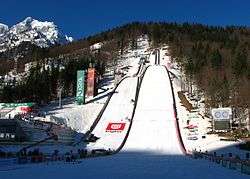 | |
| Constructor(s) |
Ivan Rožman (original) Stanko Bloudek (dev.) Klemen Kobal (new) |
| Size | |
| K–point | 125 metres (410 ft) |
| Hill size | 138 metres (453 ft) |
| Longest jump (unofficial / fall) |
149 metres (489 ft) |
| Hill record |
142 metres (466 ft) |
| Normal Hill | |
|---|---|
| Constructor(s) | Klemen Kobal |
| Size | |
| K–point | 95 metres (312 ft) |
| Hill size | 102 metres (335 ft) |
| Longest jump (unofficial / fall) |
106 metres (348 ft) |
| Planica School/Youth Hills | |
|---|---|
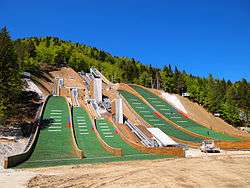 | |
| Size | |
| K–point |
from left to the right: 41, 28, 13 m (school hills) 56, 72 m (youth hills) |
| Hill size |
from left to the right: 45, 30, 15 m (school hills) 61, 80 m (youth hills) |
Letalnica bratov Gorišek (English: Flying hill of Gorišek brothers) is a 1969 ski flying hill located in Planica, Slovenia. Hill is named after the original constructors and brothers Vlado (alias "Lado") and Janez Gorišek. With total of 28 world records set it is the world leading ski jump hill in this statistics. They installed the world's steepest zip-line with average incline at 38.33% (20.9°) and maximum incline at 58.7% (30.5°) which opened on 19 September 2015.
It's the biggest of totally eight hills at Planica Nordic Centre. Yugoslavian ski jumper Miro Oman was honoured to make a premiere 135 m (443 ft) long jump on 6 March 1969 at hill test. The first ever FIS Ski Flying World Championships was organized on this hill in 1972. After Matti Nykänen set world record 191 meters at SFWC 1985, new rule by FIS was accepted where no points for jumps over this distance was awarded in order to prevent world record hunting. On 17 March 1994 Andreas Goldberger touched the snow with his hand at 202 m and made first ever over two hundred meters jump, but it was invalid. Just a few minutes later Toni Nieminen landed on his feet at 203 m and officially became the first man in history who jumped over two hundred meters. This hill is a historic place where a man for the first time jumped over 200 m.
Large hill
Bloudkova velikanka (also: Rožman/Bloudkova velikanka, Old Bloudkova velikanka, Large Rožman/Bloudek Hill, Mammoth Hill) is a large ski jump hill in Planica, Slovenia opened in 1934 by Joso Gorec's initiative. Hill was originally constructed by Ivan Rožman, that's why he resent that hill was first named after Stanko Bloudek and not him and backed up. Posthumous and many years later they credited and honoured him to rename hill as Rožman/Bloudkova velikanka. A year after opening Stanko Bloudek became in charge as main constructor improving this hill 'till his death and with his vision and skills made Planica world-famous and brought ski jumping/ski flying to a whole new dimension. As a constructor he is credited with thirteen world records and first jump in history over 100 metres in 1936 and that's how new discipline was born right on this hill. Hill's axis and name are under national monument protection and can not be changed. After almost a decade of hibernation hill was completely renovated with same characteristics as old one and opened in 2012. Right next to this one they built a brand new normal hill, which replaced the old demolished one. They chose this location mostly because of their bid for the Nordic World Ski Championships.
Abandoned hills
- In 1930, the first K20 hill was built in the middle of way next to the road between Bloudkova velikanka and Rateče hills. Abandoned but profile still seen today.
- In 1935, the first K60 hill was built in Rateče at entrance crossroad to Planica valley, later another hill added. Last time in function as K50 and 70 m in 1996. Abandoned but profile still well preserved today.
- In 1949, the Srednja Bloudkova K90 hill constructed by Stanko Bloudek was opened, in use until 2007 and completely demolished in 2012. Now replaced with complete new HS62 and 80 m hills.
- In 1952, Bloudek constructed three small K8, 30 and 40 m hills for kids to practice called »Planica school hills«, later covered with plastic and demolished in 2012. Replaced with new HS15, 30 and 45 m hills in 2014.
Zip line
Zip-line on the flying hill is the steepest in the world with 40 seconds of adrenalin fall. It was installed by Slovenian ski manufacturer Elan in August 2015. It's the first ever zip line installed on any of ski flying hills around the world. Former Slovenian alpine skier Jure Košir was honoured to be the first person who tested and descended down on 1 September 2015. For daily visitors and tourists was opened on 19 September 2015.
- start – at 1151.6 m (3,776 ft)
- finish – at 949 m (3,114 ft)
- length – 566 m (1,857 ft)
- vertical drop – 202 m (663 ft)
- duration – 40 seconds
- speed – 40 km/h (25 mph) to 90 km/h (50 mph)
- minimum/maximum ground – 3 m (10 ft) to 53 m (174 ft)
- temperature – operates from minus 10 °C (14 °F) to +40 °C (104 °F)
- average/maximum incline – 38.33% or 20.9 degrees / 58.6% or 30.5 degrees (both world's steepest)
Other objects
- Cross-country skiing track – above and underground track
- Dom Planica – The oldest object in Planica. Beds, hyperbaric chamber, current museum, garages, indoor/outside courts, restaurant
- Circle tower – media center, wind tunnel, ski jump simulator, new museum, restaurant
- RTV dom – house of Radio-Television Slovenia
- Equipment storage and technical support objects (named Kavka and Čaplja)
- Underground tunnel is connecting circle tower and Letalnica without crossing the road
- Three ski lifts – chairlift, funicular and cable railway (Hugo)
- Football pitch
Key people
Joso Gorec
He is known as the "creator" of Planica, key figure and the most significant person in the whole story. All credits go to him, without him there will be nothing. He was a Slovene sport worker, sport enthusiast and member of Ilirija Sport Club. His intention was to build the biggest hill in the world and to make relatively unknown Slovenia famous. He is the initiator and responsible that Ilirija House, now called Planica House, was built in 1931. A year later Gorec asked his club co-worker, engineer Stanko Bloudek, to draw plans for large hill. Bloudek draw plans for K80 hill, as much as International Ski Federation rules allowed at that time and found the fantastic location for it. But in 1933, suddenly out of nowhere Ivan Rožman, a construction company's owner working at time in Planica, draw plans for new, bigger K90 hill, now known as Bloudkova velikanka. Joso Gorec decided to rather build the hill by his plans. Another big achievement if Gorec was his fight for recognition of Planica and ski-flying as new discipline in annual FIS congress held in 1938 in Helsinki. He was defending plans of Stanko Bloudek, who didn't want to go there. Gorec fantastically presented Planica and ski-flying in front of FIS. But he was lucky to get a full support from Arnold Lunn, who had the same problems with FIS years ago at recognition of slalom. Lunn told FIS that they or anyone else couldn't stop ski-flying in Planica. After the end of presentation, Gorec said that FIS adopted rules only for K80 and not yet have any rules for a new discipline called ski-flying. He invited FIS to accept new rules for ski-flying as soon as possible. After this meeting FIS allowed ski-flying but only in study purposes.
Ivan Rožman
Original constructor of K-90 Bloudkova velikanka hill, which was built in two months, from October to December 1933 hill was completed. Opening competition was National Championships in February 1934, where Rožman as a first person in history used snow cement. Gorec gave him and his company permission to build the hill. He contributed all the money for the construction, together with two other business partners: manufacturer Rado Hribar from Ljubljana and with father of Slovene actor Demeter Bitenc who was renting "Bitenc Hotels". At first locals didn't want to sell the land needed for construction and the local priest Lavtižar preached to locals at liturgy and convinced them to sell the land. Soon after hill was opened Rožman and Bloudek got into conflict about original authorship and name of Bloudkova velikanka. While Joso Gorec took side with his friend Bloudek, he step out as constructor. Soon a year later Bloudek continued his work on Bloudkova velikanka. Rožman died in 1937 and conflict about authorship was forgotten for many years. Many years later they recognized him as original constructor. The full official name of the hill is now "Rožman/Bloudkova velikanka".
Stanko Bloudek
Stanko Bloudek was a constructor and the father of the first ever ski flying hill. In 1932 he was hired by Joso Gorec to draw plans for hill with size K-80. He drew plans and found an excellent location in Planica, but didn't make to realize his plans at first. Ivan Rožman who draw plans for K-90 built the original Bloudkova velikanka on location found by Bloudek. He took the one-year-old hill over in 1935, then upgraded it, enlarged it and improved it several times until his death in 1959. He is responsible for eleven world records on Bloudkova velikanka and for the first jump over 100 meters in 1936. Bloudkova velikanka was unfairly named after him, although original plan wasn't his, but he was closer to Gorec who decided about everything.
Vlado Gorišek
Vlado Gorišek (1925–1997), born in Ljubljana, more known as Lado, was the older brother of Janez Gorišek. He is known as co-constructor of Letalnica bratov Gorišek, a flying hill built in 1969, although he didn't actually draw the plans, but his younger brother Janez did while he was working in Libya in the 1960s.
Janez Gorišek
Janez Gorišek and his older brother Vlado are born in Ljubljana and they together constructed the flying hill in 1969. Janez was the main mastermind who actually draw the plans alone, but he could not be present at the construction site, because at the time he was working in Libya. However, his brother Vlado was present at the construction site from the start to the end as the main supervisor with nonstop contacts to his younger brother Janez through telephone and mail. They are responsible for a hill with the most world records, twenty-eight and for the first jump in history over 200 meters in 1994.
World records
List of all world records from both large and flying hill. Some sources claim that three world records set on 2 March 1941 by Franz Mair (109 m), Hans Lahr (111 m) and Paul Krauß (112 m) on large hill were actually not world records. They claim those jumps were actually set after Rudi Gering's 118 m world record.
Letalnica bratov Gorišek
disputed world records; claimed by some sources
|
Bloudkova velikanka
|
Cross-country skiing events
Men
|
Ladies
|
Red Bull 400
Red Bull 400 is an extreme running-up-the-hill sport event sponsored by Red Bull. It is the steepest uphill race that takes place in Europe. It is a tough 400-meter vertical sprint up the face of a ski-jump slope in Planica, Slovenia. Runners have to beat 400 meters distance from bottom to the top of the inrun of the flying hill. Runners coming from all over Europe had to beat steepest part 38° angle on the older hill and at 36° on modernized hill. First two editions on the Letalnica bratov Gorišek were held in 2012 and 2013 and cancelled in 2014 because the hill was under renovation. Competition returned in 2015 on a modernized and even bigger hill than before with totally new concrete inrun.
Men
|
Ladies
|
External links
- Planica.info (in Slovene) (in English)
- Planica Nordic Centre (in Slovene)
- Planica at Sport Institute of Republic of Slovenia (in Slovene)
Coordinates: 46°28′35″N 13°43′16″E / 46.47639°N 13.72111°E
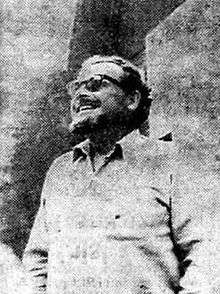
.jpg)
